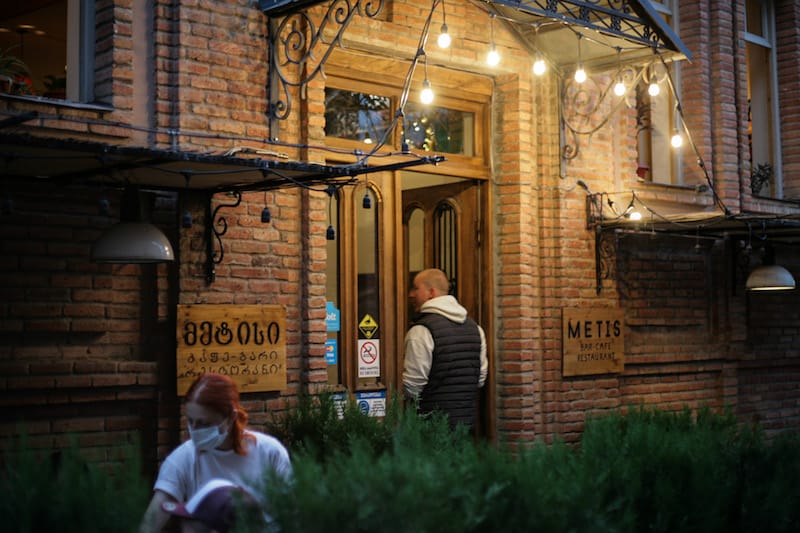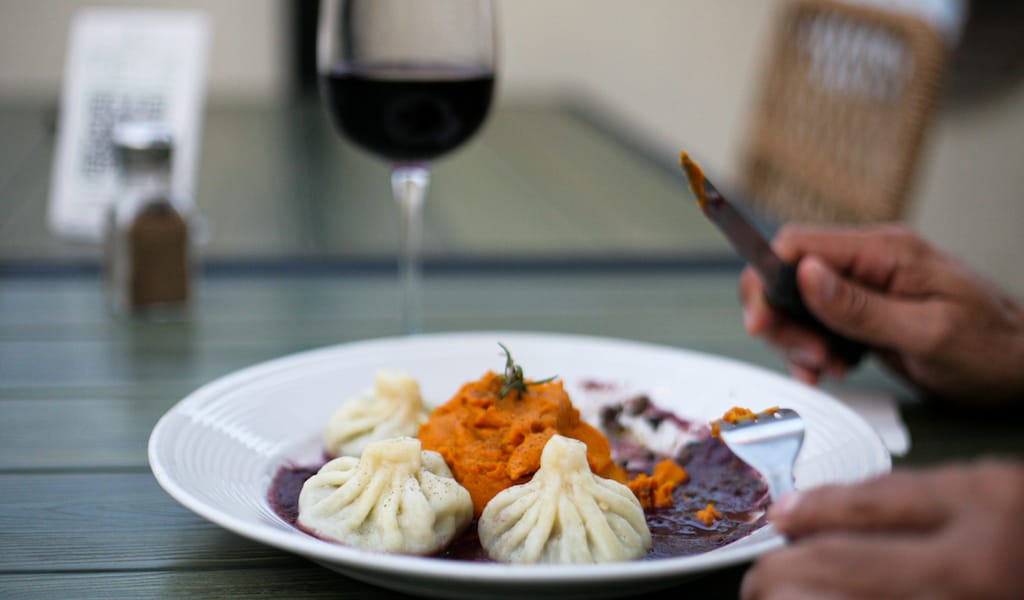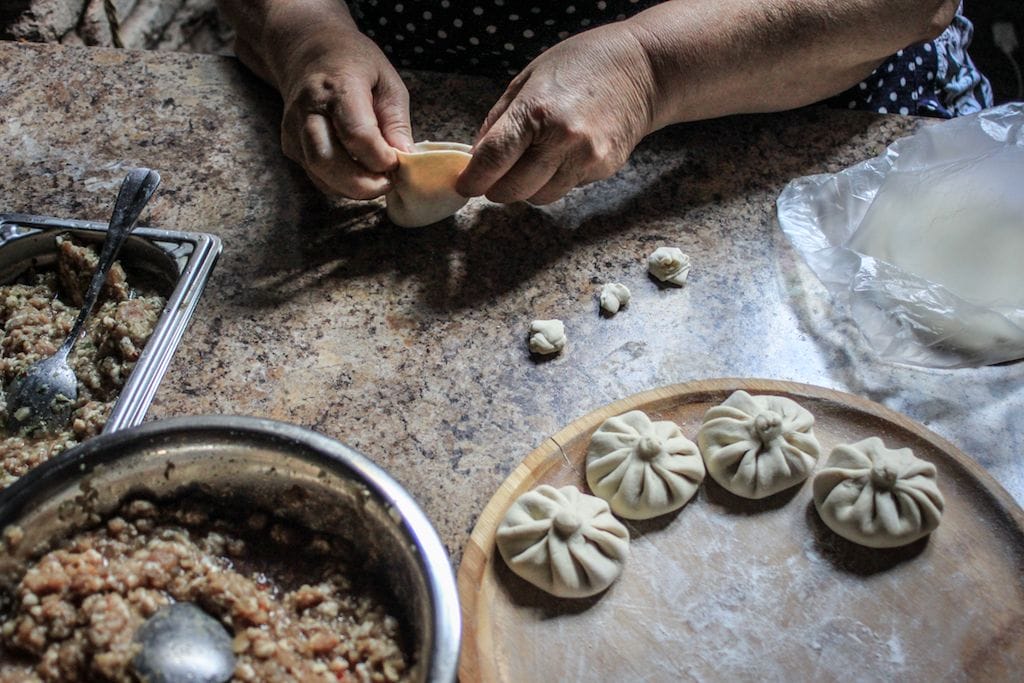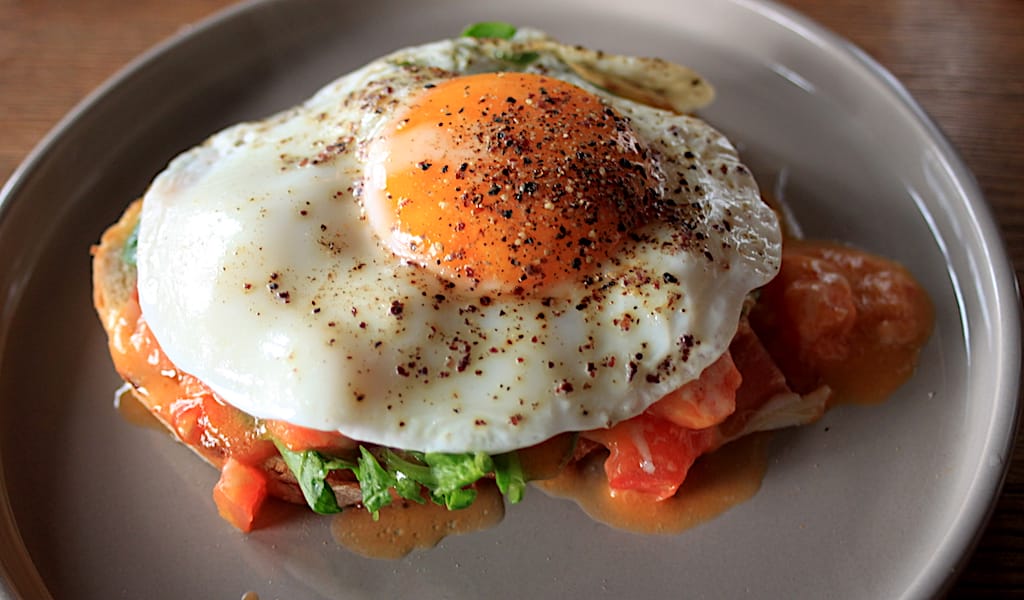Snail khinkali? It might sound, at first, like an odd combination. On closer consideration of Georgian cuisine and history, however, it makes good sense. For one thing – perhaps the most important – they’re tasty, and we have yet to hear anyone who’s tried them disagree.
The signature dish at Metis restaurant, which is – for now at least –the only place in Tbilisi one can have them, they remind us more of mushroom than of meat khinkali: savory, smooth, a little buttery, with some brightness from parsley and a hint of pastis.

Metis’ logo, a snail with a khinkali for a shell, expresses the playful blend of French and Georgian cuisines that owner Thibault Flament is pursuing in close collaboration with his chef, Goarik Padaryan. “I show her an idea, and she makes it even better,” he tells us. “Goar is the professional. We brainstorm in my broken Russian. She brings a lot of combination ideas. I do the broad strokes, she does the specifics. For example, adding pastis to snail khinkali was her idea.”
After all the experimenting, snail khinkali has become a culinary success of Metis’ kitchen, though Thibault tells us he later learned the dish may have its own even older history in the region. Folks in the city of Akhaltsikhe in the southwestern Samtskhe–Javakheti province told Thibault that over 100 years ago, French missionaries had introduced Georgia to edible snail cultivation. It would have taken only a little imagination to think of filling the famous Georgian dumpling with snail – something that’s done in Meskheti today. Thibault mentions that locals also told him of duck khinkali, which perhaps may have the same source of influence. Either way, snail khinkali speaks for itself, no matter where or how the dish originated.

Metis’ beef bourguignon khinkali, however, is unquestionably a new invention by Thibault and Goarik, as is their Saperavi French onion soup. We find their blending of flavors works well. It feels like what a culinarily minded French person living in Georgia would naturally do in their own kitchen – not a forced or overly conceptual fusion of one fixed cuisine into another.
Thibault’s interest in cooking began early. His father had wanted to be a chef, but ended up training as an engineer. Thibault followed in his footsteps, but managed to also break into the restaurant business. Originally from France, from the age of 9 to 12 he lived with his family in the US state of Washington. His engineering career eventually took him to Chad, where he began to explore the local and continental cuisine. Even more curious, Thibault tells us it was in Chad of all places, not the United States, that he was first introduced to Mexican food. Inspired further by conversations with an anthropologist friend, he says these experiences got him thinking about cross-cultural influences in cuisine and the anthropological and politically complicated French idea of métissage – or the “mixture” of cultures and race/ethnicity into an identity. He began to notice just how much national and regional cuisines are the result of cross-cultural exchange.
It feels like what a culinarily minded French person living in Georgia would naturally do in their own kitchen – not a forced or overly conceptual fusion of one fixed cuisine into another.
“I liked the idea of food métissage. It tells us a lot about our history,” he says, bringing up two favorites in France with outside origins, the croissant and couscous. As the restaurant name advertises, Metis is devoted to this idea.
It wasn’t just thoughts of cross-cultural exchange that set Thibault on the path to Metis. In Chad, he met his friend Jeremie Blaise, now his partner in the restaurant. But perhaps most importantly, Thibault says, it was his house in the African country that jettisoned him toward living out his father’s early dream of working in the restaurant world. He tells us how his home became a place anyone could come by for a drink, and he then began hosting sit-down dinners for around 20 people, and barbecues for 50. Given the frequency and scale of this hospitality, it struck him that he might open a restaurant somewhere, someday.

It didn’t happen in Chad, but it did in Tbilisi. Thibault acquired Metis from Romain Brisson, who now runs Backstage76 on Chanteria St. right off of Rustaveli. Thibault says that Romain had originally envisioned Metis as a Caribbean Creole place, and since that cuisine fits the French fusion bill, he’s brought back to the menu dishes like accra (a fritters recipe from Guadeloupe, normally using cod, but Metis serves a fishless variant made of carrot, zucchini and potato) and sauce chien (literally, “dog sauce,” a spicy vinegar sauce also from the French West Indies).
But Thibault’s vision was for Franco-Georgian fusion, and so snail khinkali was soon brought to Tbilisi. While the snail and khinkali might initially seem like an unlikely Franco-Georgian pairing, Georgia and France are of course both renowned for wine. Unsurprisingly, Thibault is exploring the possibility of offering Franco-Georgian blends. We tried a couple of these from Vismino at Metis – a Saperavi-Cabernet Franc and a Khikhvi-Sauvignon Gris that were both pleasantly balanced.

Metis stands on a corner in the middle of charming Shavteli Street, a narrow cobblestone lane with ivied walls and balconies and the 6th-century church of Anchiskhati, the most ancient in the city. From Metis’ roof terrace, with its sailcloth awnings, we can see just how well situated the restaurant is. Across from the iron gates of the church is the popular Cafe Leila with its spectacular muqarnas crown molding. Shavteli also boasts the famous whimsical clock tower of the Gabriadze puppet theater, an emblem of Tbilisi.
Thibault says he wants Metis to be a spot where people from everywhere exchange travel notes. In our experience, his dream is already coming true. The rooftop terrace especially draws locals, travelers and expats together, and it is not at all uncommon for people to start up conversations that can last through the evening across tables. More than once, we have heard such chats begin with some friendly advice offered to deliberating diners: “Yes. You should definitely try the snail khinkali!”
Jason AlexanderIrina Karabashidi
Published on September 22, 2021
Related stories
June 30, 2022
Tbilisi | By Jason Alexander
TbilisiSnail khinkali? It might sound, at first, like an odd combination. On closer consideration of Georgian cuisine and history, however, it makes good sense. For one thing – perhaps the most important – they’re tasty, and we have yet to hear anyone who’s tried them disagree. The signature dish at Metis restaurant, which is –…
March 4, 2016
Food ToursQuick bite: On this Tbilisi food tour – an epic day of eating – we’ll explore the delicious roots of a cuisine that developed over centuries of Georgia being a juncture on the Silk Road. Our day begins where Tbilisi got its start millennia ago, by the natural hot springs in the oldest part of…
December 14, 2021
Tbilisi | By Jason Alexander
TbilisiWith 2021 drawing to a close, we have much to be thankful for. Though Tbilisi, like all of Georgia, still faces struggles with the continuing pandemic, the harrowing days of 2020 – with its curfews and restrictions on gatherings (especially painful for Georgians, who are in the habit of meeting in large groups of friends…




















































































